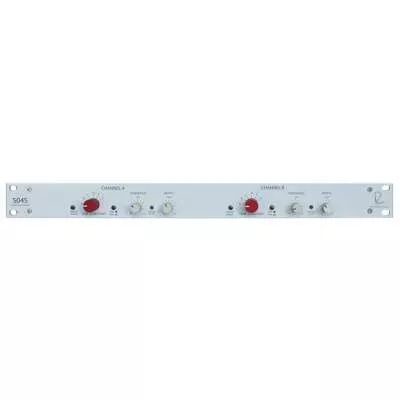We use cookies to make your experience better. By remaining on this website you indicate your consent. Learn more.
Rupert Neve Designs Portico 5045 Primary Source Enhancer
Rupert Neve Designs Portico 5045 Primary Source Enhancer
 FREE Shipping
FREE Shipping FREE Tech Support
FREE Tech Support SKU
RUPERT-NEVE-DESIGNS-5045
$1,999.00
Easy finance available for this product.
Questions? Find a Better Price?
 Contact Us
Contact UsRupert Neve Designs Portico 5045 Primary Source Enhancer
The Rupert Neve Designs Portico 5045 Primary Source Enhancer is a two channel device that is exceptionally useful for reduce the tendency of feedback ringing and effectively increase the level a microphone can be raised before feedback occurs in a live sound environment. The controls are easy to use and understand and generally require minimum adjustment once set properly.The 5045 shares some traits with conventional “noise gates” but operates with a different principal involved. One common aspect is that both reduce the gain during the absence of signal, or more specifically, it begins to attenuate when the level of a signal falls below a certain threshold that the operator can set. The 5045 senses when someone is speaking or singing into the mic and allows the signal to pass through, and senses when the person has stopped talking or singing and reduces the gain appropriately, which tends to help reduce the tendency of a system to feedback. Most importantly, the 5045 does not introduce filtering and digital processing to achieve significant benefits.
Operation is simple. The 5045 accepts line level signal such as the output of a microphone preamplifier or the “Insert” send of a console. The 5045 outputs are also line level that typically feed a console line input or “Insert” return. Because the 5045 uses transformer coupled inputs and outputs it easily connects to virtually any combination of balanced or unbalanced inputs and outputs provided you have commonly available appropriate adapters.
Once the 5045 is connected and power turned on the next steps are relatively simple. A good safe initial starting point is; “PROCESS ENGAGE” not pressed, “TIME CONSTANT” set to C or D, “RMS/PEAK” button not pressed (RMS mode), “THRESHOLD” all the way down or -18, and the “DEPTH” also all the way down at 0.
Now, have someone talk or sing into the microphone and press the “PROCESS ENGAGE” button and if the 5045 is connected properly there should be no change in level. As the person is talking or singing, adjust the “THRESHOLD” so that the green “PROCESS ACTIVE” LED glows solidly when they talk and dims when they stop talking (for example between sentences). Gently increase the “DEPTH” knob to about -10 dB as a starting point.
If the sound system was previously on the edge of feeding back, the above procedure should have helped. If the system volume was set low to “play it safe” and well under the feedback zone, as you learn the new box, you can try increasing the volume of the channel slowly and adjusting the “DEPTH” to achieve more volume before feedback sets in. The 5045 will not eliminate the chance of feedback given enough volume, but is generally effective at allowing both increased levels along with less chance of annoying feedback.
The Time Constant Control
The “TIME CONSTANT” control is designed to help prevent choppiness in some situations and stop feedback in other situations. It mostly sets how quickly the attenuation occurs in the quiet sections between words or sentences. “A” is the fastest and “F” is the slowest. “A” will quickly soften the level which can be advantageous when the singer is consistent and feedback howl is challenging. “F” is the safest in terms of slowly fading down, but might be a bit slow fading up again, and might be a bit slow for controlling some pesky feedback situations. “C” and “D” are moderate settings that should fit many situations and generally fade down slow enough so that the ends of words are not affected, yet fast enough to control feedback. Choose the most appropriate time constant that doesn’t soften the beginnings and endings of phrases, yet still diminishes the feedback and “boominess” of the signal.The RMS/PEAK Switch
Similarly, the “RMS/PEAK” button allows some finessing of the timing of the 5045. With the “PEAK” button pushed in, the 5045 will return to normal level from attenuation very rapidly. This may help prevent the beginnings of some words from being cut off. (It also opens the door for some creative dynamics-shaping if one uses the 5045 on musical instruments.) With the button set to “RMS”, the 5045 will behave moderately slower, but with a greater deal of perceived “musicality”. In this mode, it is relying on the “average” signal level rather than merely the loudest and briefest peaks.| Manufacturer | Rupert Neve Designs |
|---|
Write Your Own Review

